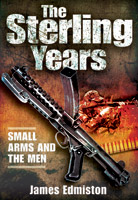A History of the Small Arms made by the Sterling Armament Company (Hardback)
Excellence in Adversity
Imprint: Pen & Sword Military
Pages: 352
Illustrations: 32 colour & 350 black and white illustrations
ISBN: 9781526773302
Published: 7th August 2020
(click here for international delivery rates)
Need a currency converter? Check XE.com for live rates
| Other formats available - Buy the Hardback and get the eBook for £1.99! | Price |
|---|---|
| A History of the Small Arms made… ePub (40.2 MB) Add to Basket | £6.99 |
An in-depth history of the small arms made by the Sterling Company of Dagenham, Essex, England, from 1940 until Sterling was purchase by British Aerospace in 1989 and closed.
The Lanchester and the Patchett Machine Carbines were both developed at Sterling Engineering Co Ltd during World War II.
With the appearance of the earliest Patchett prototypes the military began testing them in ever more rigorous trials, wherein the Patchett kept proving its merits. This led to limited UK adoption of the MkII Patchett as the L2A1 in 1953, and the ‘first Sterling’, the MkII, as the L2A2 in 1955.
Then came Sterling’s ‘Crown Jewel’, the superb Mk4, adopted as the general-issue UK ‘Gun, Sub-Machine, L2A3’ in September, 1955. Manufactured briefly but intensively by ROF Fazakerley (1955-1959) and by Sterling for over 30 years, nearly 4000,000 were made.
Unlike wraparound bolt designs like the UZI, the Sterling was capable of being truly silenced with standard 9mm ball ammunition (as opposed to being merely ‘supressed). The excellent silenced Sterling-Patchett Mk5, adopted as the UK L34A1 in 1967, is the only Sterling remaining in British Service.
All prototypes, military Marks, commercial and licensed production models of the Sterling are described, including the Canadian C1 SMG and the Indian 1A Carbine. Contains notes on manufacturing methods and procedures as used at Sterling, ROF Fazakerley, Canadian Arsenals Limited and the Indian Small Arms Factory, Kanpur (Cawnpore), plus extensive notes on inter-model interchangeability, serial number ranges, quantities produced, client-country purchases of the various Sterling Marks, and accessories.
"A interesting book for those with memories and/or an interest in Small Arms."
Ordnance Society - Newsletter No.134, 07/2021
A documentation of great interest on one of the leading British armaments factories in its niche market during the Second World War and the Cold War.
Miniaturas JM
Read the full Spanish review here
It's a weighty, serious, well-illustrated book on the British Army's later Small Metal Guns.
WW2 Talk
Read the full review here
The story of the company and the detail of their products is simply stunning. The research that must have gone into this is a real credit to the authors. I own a Sterling (albeit de-activated) and now feel I know so much more about it, and the company that made it, before it was sold and swallowed up by British Aerospace in 1989. Definitely recommended.
Military Model Scene, Robin Buckland
Read the full review here
...offers an excellent examination of Sterling guns.
The Historical Miniatures Gaming Society
Click here for the full review
Verdict: One for the serious collector or enthusiast. This is a valuable resource for anyone with an interest in firearms manufactured by Sterling.
Classic Military Vehicle, February 2021
If you have an interest in small arms then this is a book that belongs in your library or book shelf. The book does a great job of providing the reader with the story of the weapons that evolved into the Sterling sub-machine gun and the changes in design that took place over that history. The result was a weapon that served in many fields of conflict and performed admirably.
Armorama
Read the full review here
This is a heavy book and extremely well researched, the authors are to be commended for the authoritative work that they have produced.
Army Rumour Service (ARRSE)
Read the full review here
This has to be the Book of the Year for small arms. The authors have provided a detailed history of the Sterling Armament Company and its most famous product, the Sterling sub-machine-gun – Most Highly Recommended
Firetrench
Read the full review here
If you're interested in armaments of any kind, this is one for your collection. Comprehensive and very, very interesting.
Books Monthly
About James Edmiston
Edinburgh-born James Edmiston, whose interests feature rugby and music, owned the Sterling Armament Company from 1972 until 1983, when steady sub-machine gun production was complimented by new product research and development and plant investment. His modest Oxford law degree assisted during constant harassment by a state apparently hell-bent in destroying any competition from private industry. He is intensely proud of the achievements of the Sterling team.
About David Howroyd
David Howroyd joined the Sterling Group of Companies after completing his tool-making apprenticeship with the Plessey Company in 1944. He was ‘called up’ for National Service with the post-war RAF between 1946 and 1948, where his skills were especially sought due to the release of thousands of skilled RAF veterans into post-war industry. He returned to the Sterling Engineering Company in late 1948. After 1972 he became General Manager, and subsequently the Works Director of Sterling Armament Co Ltd.
About Peter Laidler
Peter Laidler, himself the son of a long-serving British Army Warrant Officer, attended the Armourers’ Course at the Army Apprentices School, Carlisle between January, 1963 and December, 1965. Peter Laidler went to Malaya with the last British Forces to be based there. This was followed by service with the 1st, 4th and 8th Royal Australian Regiments plus the New Zealand Infantry in South-East Asia, Australia and New Zealand.

















